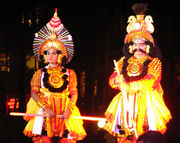Raja
- For other uses, see Raja (disambiguation) and Rajah (disambiguation).
Raja (also spelled rajah, from Sanskrit rājān-, nominative rājā, also written raj in many modern languages) is an Indian term for a monarch, or princely ruler of the Kshatriya varna. The female form, the word for "queen", mainly used for a raja's wife, is rani (sometimes spelled ranee), from Sanskrit rājñī, or ratu in Southeast Asia.

The title has a long history in the Indian subcontinent and Southeast Asia, being attested from the Rigveda, where a rājān- is a ruler, see for example the (dāśarājñá), the "battle of ten kings".
Sanskrit rājān- is cognate to Latin rēx (genitive rēgis), Gaulish rīx etc., originally denoting tribal chiefs or heads of small 'city states'. It is ultimately derived from a PIE *h3rẽǵs, a vrddhi formation to the root *h3reǵ- "to straighten, to order, to rule". The Sanskrit n-stem is secondary in the male title, apparently adapted from the female counterpart rājñī which also has an -n- suffix in related languages, compare Old Irish rígain and Latin regina. Cognates of the word Raja in other Indo-European languages include English reign and German reich.
Rather common variants in Hindi, used for the same royal rank in parts of India include Rana, Rao, Raol, Rawal and Rawat.
Raja, the lower title Thakore and many variations, compounds and derivations including either of these were used in and around South Asia by most Hindu, Muslim and some Buddhist and Sikh rulers, while Muslims also used Nawab or Sultan, and still is commonly used in India. In Pakistan, Raja is still used by many Muslim Rajput clans as hereditary titles. Raja is also used as a given name by Hindus and Sikhs.
Rajas in the Malay world
- In Indonesian language, the word "Raja" means "King". Many of the leaders of local tribes and old kingdoms have that title before Indonesia became an independent nation.
- The ruler of the state of Perlis, Malaysia is titled the Raja of Perlis. Most of the other state rulers are titled Sultans. Nevertheless, the Raja has equal status with the other rulers and is one of the electors who designate one of their number as the Yang di-Pertuan Agong every five years.
- The White Rajahs of Sarawak in Borneo were James Brooke and his dynasty.
- In the Philippines, Italian historian Antonio Pigafetta relates in his document of the first circumnavigation that when the Portuguese explorer Ferdinand Magellan reached on March 28, 1521, the island-port of Mazaua in Mindanao he was met by Raia Siaiu, the King of Mazaua and Raia Calambu, King of Butuan. Magellan entered into the first recorded blood compact (cassi cassi was the Malayan term Magellan used) with Raia Siaiu. When the Spanish fleet, led by Miguel López de Legazpi, arrived in Manila, they were met by the King of Manila, Rajah Sulaiman III. In the south of the country, various sub-divisional princes among the Moro peoples are still given the titles Rajah or Maharajah.
- All of the major kingdoms in the Philippines (including the Luzon Empire and excluding the Sultanate of Maguindanao) were annexed by the Spanish Empire in the 16th century.
- Various traditional princely states in Indonesia still style their ruler Raja, or did so until their abolition after which the title became hollow, e.g., Buleleng on Bali.
See also
- Alphabetical
- Amir Ali Khan
- Bais Rajput
- Bhati
- Bhatti
- Chadhar
- Chandela
- Chattar
- Chauhan
- Dhanyal
- Gakhars
- Ghorewaha
- Janjua
- Kahlotra
- Kirar Rajput
- Kishtwaria
- Kshatriya
- Maharaja
- Mangral
- Minhas
- Narma
- Pakhral
- Pharwala
- Ranawat
- Ranial Rajputs
- Rathore
- Shah
- Sohlan
- Sulehria
- Tanwar
- Thakial Rajputs
- Yadav
Sources and references
- Indian Princely States, the most comprehensive, specialised site on (princely) (e)states in British India
- RoyalArk (more elaborate, on a smaller number of dynasties)- here India
- WorldStatesmen- Indian princely states, here K-Z
|
|||||||||||